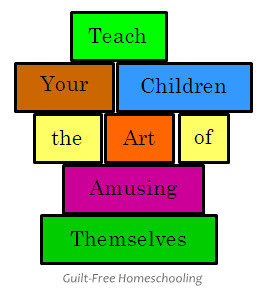“I’m bored.” “Mommy, come play with me.” Have you heard these laments lately? By teaching your children to enjoy a variety of “by-myself” activities, you can prevent the incessant whining, cure the boredom, and gain a tiny bit of free time for yourself. You will also be fostering independence in your children by teaching them the basics of teaching themselves.
Your time, Mom, is too valuable to be spent merely entertaining your children. Individual entertainment is a skill very valuable in homeschooling. A student of any age needs to be able to learn on his own, and solitary time is the ideal situation in which to practice independent study. Once they have acquired interest in a few solo activities, your students can entertain themselves while you tend to their siblings, to your housework, or to your own leisure pursuits. They can begin to see the advantages of striving to complete their schoolwork quickly in order to return to their own recreational activities. Children who learn how to entertain themselves will be much more content personally and able to adapt to new circumstances better than will their counterparts who rely on others for entertainment.
Just as some tiny tots need to be spoon-fed the first bite or two of a new food before taking over to feed themselves, some children may need guidance in learning to play by themselves. Start an activity with them, and then slowly wean yourself away from the action: dump out a 100-piece jigsaw puzzle, and get Sammy started on assembling the easy border pieces while you sort out the pieces for a few main elements in the puzzle. (Do not assemble the parts completely, just sort or put a few pieces together to help Sammy along. This is the all-important “teaser” stage: you want to make it irresistible for Sammy to finish the puzzle.) Before long, Sammy will be engrossed in his task with enough confidence to carry him through, and you can excuse yourself to shuffle the laundry, promising to check on his progress later (then be sure that you do come back to praise him). Sometimes, Mom or an older sibling may need to give a few quick lessons in a new activity, but the real learning sets in when the child begins to explore a craft or leisure pursuit on his own. Be sure to praise the child for his time dedicated to working alone, and show him how valuable the skills are that he is developing.
Consider these leisure pursuits that work well as independent activities:
–jigsaw puzzles
–crossword & other word puzzles
–sudoku & other number/logic puzzles
–solitaire card games
–sewing, crocheting, knitting & other needle arts
–painting & drawing
–whittling & woodworking
–Lego’s & other construction toys
–building models
–gardening
–reading
–bicycling, rollerblading, & other individual sports
–(what can you add to this list?)
On one particularly lazy day when my children were small, we had picnicked at a city park and the children were growing bored with the playground equipment. With too much month left at the end of the money, we were seeking no-cost diversions, but boredom was overtaking the usual ideas. As we sat at a picnic table discussing what else we could do for the day, I picked up a handful of the small stones and pea gravel that covered the playground surface. Fingering the tiny rocks led to watching them tumble across each other. Before long, we had stumbled upon a new and challenging game: Rock Stacking. We spent the next hour stacking up the pebbles and seeing who could create the tallest stacks. Height was replaced by quantity as we began counting who could stack the most rocks before their stack toppled over. Soon other children had joined us and we had several families involved with our new game, all cheering each other’s accomplishments. Steady hands were as valuable as a sharp eye for spotting flat surfaces on the rocks, and all participants had to be careful not to jiggle the table and send everyone’s stack back to the starting line. It was a wonderfully enjoyable afternoon that I will not soon forget, especially the amazement on the faces of the children we did not know, who begged to be included in our fun — with not a penny of expenditure to anyone. I am sure that none of those other children would ever previously have considered joining a friend who asked, “Hey, want to go stack rocks?”
As they grow into adults, the inventiveness and creativity that has been developed through individual activities and solo entertainment will show forth in the ability to provide cheap (or free) alternatives to eating out or going to movies. Children who have grown up constantly being entertained by their parents or older siblings have little imagination for how to spend “down time,” so they continue to seek someone to entertain them and need a constant flurry of activity to keep them happy (usually at considerable financial cost). My daughter’s college friends quickly ran out of money and ideas for recreation, prompting the invention of her Shopping Trip Bingo game, an exercise in no-cost entertainment. We have often gone on short nature hikes as a family, and our children have continued their love of that no-cost activity by taking special friends back to our favorite lake for quiet walks and peaceful getaways.
To paraphrase an old saying, “If you give a man a fish, that man knows where to go to get fish.” So if you consistently entertain your children when they are bored, your children will always know whom to go to for entertainment. However, a child who can occupy himself with satisfying leisure activities is learning hobbies that will last a lifetime. The more he explores and learns on his own, the more he hones his skills for teaching himself — skills valuable for homeschooling and for continuing his education throughout life. Any time that you spend in teaching your child a solitary activity (knitting, for example), will be returned to you in multiplied hours that you can dedicate to other pursuits while your child carries on independent activities. Not every child can automatically see how to entertain himself, some need more guidance than others, and a few will continue to need Mom’s approval and encouragement from time to time, but a child who learns to amuse himself will be opening the door to a world full of knowledge and adventure.






 Guilt-Free Homeschooling is the creation of Carolyn Morrison and her daughter, Jennifer Leonhard. After serious disappointments with public school, Carolyn spent the next 11 years homeschooling her two children, from elementary to high school graduation and college admission. Refusing to force new homeschooling families to re-invent the wheel, Carolyn and Jennifer now share their encouragement, support, tips, and tricks, filling their blog with "all the answers we were looking for as a new-to-homeschooling family" and making this website a valuable resource for parents, not just a daily journal. Guilt-Free Homeschooling -- Equipping Parents for Homeschooling Success!
Guilt-Free Homeschooling is the creation of Carolyn Morrison and her daughter, Jennifer Leonhard. After serious disappointments with public school, Carolyn spent the next 11 years homeschooling her two children, from elementary to high school graduation and college admission. Refusing to force new homeschooling families to re-invent the wheel, Carolyn and Jennifer now share their encouragement, support, tips, and tricks, filling their blog with "all the answers we were looking for as a new-to-homeschooling family" and making this website a valuable resource for parents, not just a daily journal. Guilt-Free Homeschooling -- Equipping Parents for Homeschooling Success!

Recent Comments